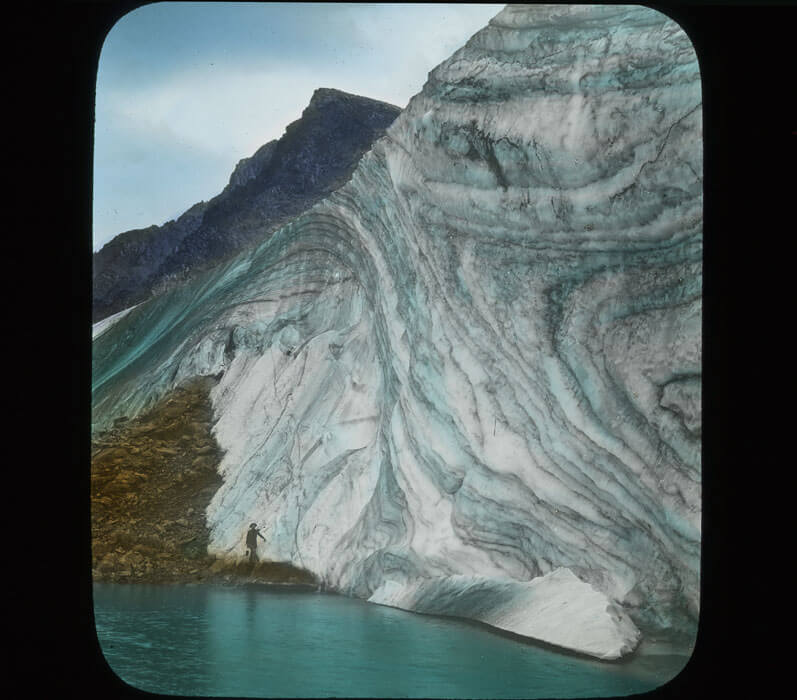Grasshopper Glacier: A Frozen Plague
By Terry Habeger
Broadcast 7.13 & 7.16.2022

Grasshopper Glacier in 1900. Photo by J.E. Haynes, CC-by-SA 4.0.
Listen:
As a teenage boy on the farm in Iowa, I experienced a horde of grasshoppers while unloading a wagon of oats. The surface was covered with grasshoppers! It was not difficult to grab one, and when I did, it would “spit tobacco.” I have since learned that spitting a dark liquid is a defense mechanism. Memories like this one have stuck with me, and in part fueled my interest in the mass of grasshoppers that somehow ended up in Rocky Mountain glaciers.

Rocky Mountain locust, Melanoplus spretus. Illustration by Julius Bien, public domain.
In the late 1800s the air was so thick with a swarm of grasshoppers that the sun was blotted out for up to six hours. Grasshoppers that exhibit this swarming behavior are also known as locusts. When they swarm, something akin to a mass hysteria occurs. Their serotonin levels increase, their bodies turn dark, their wings grow longer and their appetites increase. Crops would be devoured to nothing, a season’s work on the land annihilated. It wasn’t just the crops they ate; they would eat clothes, the wool off sheep, and even themselves, everything “except the mortgage,” as farmers were known to say. These grasshoppers’ genus name Melanoplus comes from Latin, meaning “burnt place,” which alludes to the devastation caused by the swarm. The species name spretus means “despised.”
In 1875, Doctor Albert L. Child of the U.S. Signal Corps watched a mile-high swarm of grasshoppers pass overhead for five straight days in Nebraska. In what came to be known as “Albert’s Swarm” he calculated the size of the swarm by telegraphing various towns to judge its size. He estimated the swarm to be 110 miles wide, 1800 miles long, and containing 12.5 trillion grasshoppers!

Range of the Rocky Mountain locust, 1877. Map by Charles Valentine Riley, public domain.
The migratory grasshoppers traveled great distances. Passing over the Rocky Mountains, they sometimes encountered cold and windy winter conditions. Those that did not survive fell into the snow and became embedded in the ice. Multiple layers of frozen grasshoppers in the glaciers indicate repeated occurrences of their demise as they migrated over the area. James P. Kimball’s 1898 survey in the Beartooth Mountains estimated that thousands of tons of grasshopper remains could be found on the lower edge of a glacier. He noted that not a fragment of ice could be broken without finding the remains of grasshoppers.
Grasshoppers in glaciers have been with us for a long, long time. In 1994, scientists radiocarbon-dated the remains of grasshoppers in a Wyoming glacier, and found they had been trapped in the 1300s.
But surprisingly, the swarms of grasshoppers in the U.S. pretty much disappeared in the late 1800s, and this species is now considered extinct! How could this happen? There are varying theories, of course, but most center around the increase in human population, the cultivation of land, and climate change. The destruction of grasshopper breeding grounds at Three Forks, Montana, was believed to be due to the expansion of agriculture and livestock raising.
So I am left wondering, where can I find these grasshopper glaciers now? At one time Grasshopper Glacier in the Beartooths was a tourist attraction that could be reached by foot, horse, or Jeep. But I was sad to read that no grasshoppers were found on a visit to this glacier in 2015!
The grasshoppers I experienced as a boy are probably still with us, which is likely since there are more than 10,000 species of grasshoppers. So I must ask, are we better off now that the swarming grasshoppers in the U.S. are extinct? Are there other species that will evolve into the swarming variety? Time will tell, I guess.
Every week since 1991, Field Notes has inquired about Montana’s natural history. Field Notes are written by naturalists, students, and listeners about the puzzle-tree bark, eagle talons, woolly aphids, and giant puffballs of Western, Central and Southwestern Montana and aired weekly on Montana Public Radio.
Click here to read and listen to more Field Notes. Field Notes is available as a podcast! Subscribe on iTunes or wherever you listen to podcasts.
Interested in writing a Field Note? Contact Allison De Jong, Field Notes editor, at adejong [at] montananaturalist [dot] org or 406.327.0405.
Want to learn more about our programs as well as fun natural history facts and seasonal phenology? Sign up for our e-newsletter! You can also become a member and get discounts on our programs as well as free reciprocal admission to 300+ science centers in North America!












